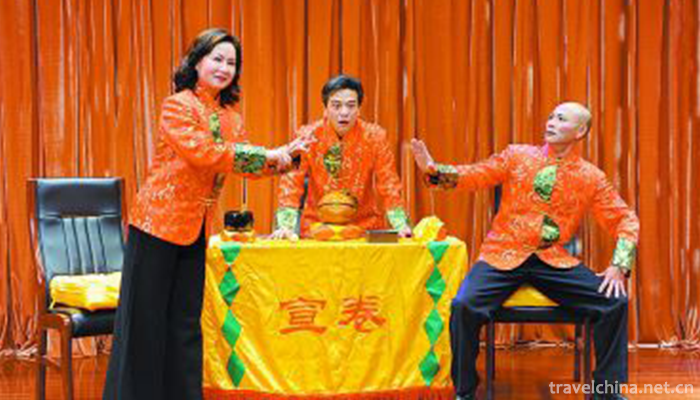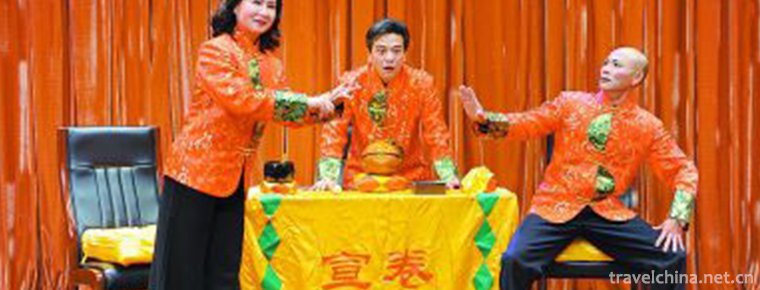Pudong Publicity Book
Pudong Publicity Book
Nanhui Xuanjuan is an ancient traditional art of rap and singing. Xuanjuan originated from "vulgar speaking" in Tang Dynasty and "Tanjing" in Song Dynasty. It is a term used by Buddhists and their followers to preach "Baojuan", which later evolved into folk art. Xuanjuan, also known as "Nian Xuanjuan", first appeared in the temple fair of social drama, then entered the Tea House Hotel and the rural living room. In the countryside, there is a custom of "reading Xuanjuan" from spring tillage to autumn harvest. At the end of the nineteenth century, Suzhou Xuanjuan spread to Zhoupu, Nanhui Xuanjuan spread to Shanghai. Qingpu, Songjiang, Jiading and other Shanghai suburbs were introduced from Kunshan in the late Qing Dynasty and early Republic of China. Therefore, Nanhui Xuanjuan, also known as Pudong Xuanjuan, was the earliest one in Shanghai.
origin
The earliest form of publicity performance is single-file, one person sings while turning the publicity roll while hitting wooden fish. After the formation of double gear, that is, a bell. Nanhui's roll is in four stalls, the left side of the desk is for the master, and the actor is playing "Lao Lang" (sandalwood board); behind the master, she sits down and plays female actors (ladies, girls, etc.) as well as big and small wooden fish; in front of the right, she pulls Erhu, sings dragon tunes, and plays the roles of "Running Dragon Set" (hiring, duty, etc.); in the back of the right, she knocks "hitter" (hitting bells), and plays backhorns and heels. Sing and drag. "Four stalls" roll-out actors are shrewd, with clear roles and strong artistic appeal.
Xuanjuan has rich bibliographies and long stories, such as Shuangzhufeng, He Wenxiu and Xiaodeng Ji. Its short stories are very distinctive, such as "Flower Names in December" and "Flower Names in December" and so on.
Present situation
Nanhui Xuanjuan has always been closely linked with current affairs and politics, such as holding special singing performances to celebrate the victory of the Anti-Japanese War in the period of the Anti-Japanese War, publicizing the Marriage Law "Daughter-in-law sighs" after the founding of the People's Republic of China, and "Family Running for Riches" during the period of reform and opening up. Up to now, the Xuanjuan is still a popular traditional folk music art in Zhoupu, Hengwu, and Watt


-
1.Sliced beef and ox organs in chili sauce
Sliced beef and ox organs in chili sauce is a famous dish in Chengdu, Sichuan
Time 2018-10-13 -
2.Caoxi Hot Spring Holiday Resort
Caoxi Hot Spring Holiday Resort is located in Qujiang Maba, Shaoguan City. It is the largest hot spring villa resort in Guangdong Province. It is located on 106 National Highway under the outlet of Sh
Time 2019-01-04 -
3.Qinghui Garden
Qinghui Garden is an ancient garden building built in Ming Dynasty. Located in Qinghui Road, Daliang Town, Shunde District, Foshan City, Guangdong Province,
Time 2019-02-07 -
4.Big Buddha Cultural Tourist Area in Zigong Rong County
The Dafo Cultural Tourist Area of Zigong Rong County was opened to the outside world in 1982. It covers an area of 32,470 square meters and has a building area of 3,403 square meters. There are a wide
Time 2019-03-22 -
5.Hua Chao Opera
Huachao Opera, a local traditional drama in Zijin County, Guangdong Province, is one of the national intangible cultural heritage.
Time 2019-05-04 -
6.Construction Techniques of Hakka Tulou
Hakka Tulou building construction technology, Fujian Longyan City Nanjing County, Huaan County local traditional building construction technology, one of the national intangible cultural heritage.
Time 2019-05-09 -
7.Gongs and drums
The Gong and drum books used to be called "Taibaoshu", "Taibao" is derived from the activities of "Taibu" in the countryside of Shanghai suburbs and counties, which seeks
Time 2019-05-15 -
8.Legend of Camel Spring
Camel Spring is a provincial key cultural relic protection unit and a patriotic education base. Located in Jiezi Township Unity Village, with convenient transportation and direct access to tertiary oi
Time 2019-05-15 -
9.Taohuawu Wood Engraving New Year Picture
Taohuawu New Year Picture is a Folk Woodcut New Year Picture in the south of the Yangtze River. It was named for its production in the area of Taohuawu in Suzhou. It and the woodcut New Year pictures
Time 2019-06-18 -
10.Yi Peoples Cigarette Box Dance
Yi cigarette box dance, the traditional dance of Hani Yi Autonomous Prefecture in Honghe, Yunnan Province, is one of the national intangible cultural heritage.
Time 2019-07-12 -
11.Corn and sparerib soup
Corn and spareribs soup is a tonic soup, the main ingredients are corn and spareribs, the main cooking technology is stew. Corn can reduce the blood cholesterol concentration and prevent it from depos
Time 2020-03-16 -
12.Administrative division of Panzhihua
Panzhihua City has 5 county-level administrative divisions (Municipal District 3, county 2) and 49 township level administrative divisions (street 11, town 23, township 15). It covers an area of 7440 square kilometers and has a population of 1.12 million. Panzhihua Municipal People's government is located at No. 2, bingcaogang street, East District.
Time 2020-12-14